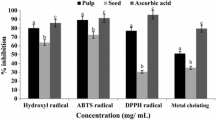Abstract.
This work was carried out to investigate the pulp composition of four mango cultivars (Haden, Tommy Atkins and Ubá) at the ripening stage in relation to three components with antioxidant potential (total phenolics, carotenoids and ascorbic acid). Total phenolic compound content was estimated by the Folin-Ciocalteu reagent and total carotenoid content by spectrophotometry at 450 nm. The contents of β-carotene and total vitamin C (ascorbic acid and dehydroascorbic acid) were quantified by high performance liquid chromatography. Differences were found among the four mango cultivars in all the components analyzed. The content of phenolic compounds ranged from 48.40 (Haden) to 208.70 mg/100 g (Ubá); total carotenoid from 1.91 (Haden) to 2.63 mg/100 g (Palmer); β-carotene from 661.27 (Palmer) to 2,220 μg/100 g (Ubá) and total ascorbic acid ranged from 9.79 (Tommy Atkins) to 77.71 mg/100 g (Ubá). These results corroborated previous information that mangoes are a good source of antioxidants in human diet.



Similar content being viewed by others
Abbreviations
- AA:
-
= Ascorbic acid
- DHAA:
-
= Dehydroascorbic acid
- GAE:
-
= Gallic acid equivalents
- HPLC:
-
= High performance liquid chromatography
- TSS:
-
= Total soluble solid.
References
Kauer C, Kapoor HC (2001) Antioxidants in fruits and vegetables–the millenium’s health. Int J Food Sci Technol 36: 703–725.
FAO STAT (2005) FAO Statistical Database – Agriculture. http://apps.fao.org. Acessed: February, 2005.
Shieber A, Ulrich W, Carle R (2000) Characterization of polyphenols in mango puree concentrate by HPLC with diode array and mass spectrometric detection. Innov Food Sci Emerg Technol 1: 161–166.
Diplock AT, Charleux Jl, Crozier-Willi G, Kok Fj, Rice-Evans C, Roberfroid M et al. (1998) Functional food science and defense against reactive oxidative species. Br J Nutr 80: s77–s112.
Chytil F (1999) Vitamin A: Not for vision only. Br J Nutr 82: 161–162.
Kris-Etherton PM, Hecker KD, Bonamone A, Coval SM, Binkoski AE, Hilpert KF, Griel AE, Etherton TD (2002) Bioactive compounds in foods: their role in the prevention of cardiovascular disease and cancer. Am J Med 113: 71S–81S.
Bravo L (1998) Polyphenols: chemistry, dietary sources, metabolism, and nutritional significance. Nutr Rev 56: 317–333.
Anilakumar KR, Khanum f, Krishna KRS, Santhanam K (2003) Reduction of dimethylhydrazine-induced cytotoxicity by mango fruit bar: changes in antioxidant enzymes in rats. Plant Foods Hum Nutr 58: 1–11.
Lee SK, Kader A (2000) A Preharvest and postharvest factors influencing vitamin C content of horticultural crops. Postharvest Biol Technol 20: 207–220.
Crisoto, C (1994) Stone Fruit maturity indices: a descriptive review. Postharvest News and Information. v. 5, n. 6, 65N–68N.
Bloor SJ (2001) Overview of methods for analysis and identification of flavonoids. Methods Enzymol 335: 3–14.
Singleton VL, Orthofer R, Lamuela-Raventós RM (1999) Analysis of total phenols and other oxidation substrates and antioxidants by means of Folin-Ciocalteu reagent. Methods Enzymol 299: 152–177.
Rodriguez DB, Raymundo LC, Lee T, Simpson KL, Chichester CO (1976) Carotenoids pigment changes in ripening Mamordica charantia fruits. Annals of Botany 40: 615–624.
Higby WKA (1962) A simplified method for determination of some aspects of the carotenoid distribution in natural and carotene fortified orange juice. J Food Sci 27: 42–49.
Vinci G, Botré F, Mele G, Ruggieri G (1995) Ascorbic acid in exotic fruits: a liquid chromatographic investigation. Food Chem 53: 211–214.
Carvalho CRL, Rosseto CJ, Mantovani DMB, Morgano MA, Castro JV, Botoletto N (2004) Evaluation of mango cultivars selected by “Instituto Agronômico de Campinas” compaired to others of commercial importance. Rev Bras Frutic 26: 264–271.
Van Buren JP (1984) Function of pectin in plant tissue structure and firmness. In RH. Walter (Ed.), The chemistry and technology of pectin (pp. 1–22). New York: Academic Press.
Winkler BS, Orselli SM, Rex TS (1994) The redox couple between glutathione and ascorbic acid: A chemical and physiological perspective. Free Radic Biol Med 17: 333–349.
Stahl W, van den Berg H, Arthur J, Bast A, Dainly J, et al (2002) Bioavailability and metabolism. Mol Aspects Med 23: 39–100.
Scalbert A, Williamson G (2000) Dietary intake and bioavailability of polyphenols. J Nutr 130: 2073S–2085S.
Godoy TH, Rodriguez-Amaya DB (1989) Carotenoid composition of commercial mangoes from Brazil. Libensm-Wissu-Techonol 22: 100–103.
Burns J, Fraser PD, Bramley PM (2003) Identification and quantification of carotenoids, tocopherols and chlorophylls in commonly consumed fruits and vegetables. Phytochemistry 62: 939–947.
IOM - INSTITUTE OF MEDICINE. Dietary Reference Intakes for Vitamin C, Vitamin E, Selenium, and Carotenoids. National Academy Press, Washington, DC., 2000, 506p.
Nagy S (1980) Vitamin C contents of citrus fruit and their products: a review. J Agric Food Chem 28: 8–18.
Acknowledgments
The authors thank the “Tropical Indústria de Alimentos” (Visconde do Rio Branco - Minas Gerais, Brazil) and Mr. Moacir Brito Oliveira (Technical Assistant of ABANORTE, Janaúba - Minas Gerais, Brazil) for supplying the mango fruits.
Author information
Authors and Affiliations
Corresponding author
Rights and permissions
About this article
Cite this article
Rocha Ribeiro, S.M., Queiroz, J.H., Lopes Ribeiro de Queiroz, M.E. et al. Antioxidant in Mango (Mangifera indica L.) Pulp. Plant Foods Hum Nutr 62, 13–17 (2007). https://doi.org/10.1007/s11130-006-0035-3
Received:
Accepted:
Published:
Issue Date:
DOI: https://doi.org/10.1007/s11130-006-0035-3




